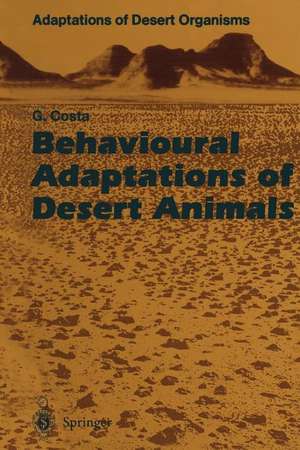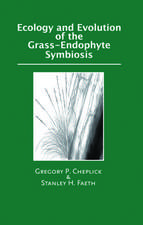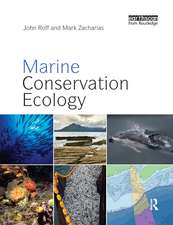Behavioural Adaptations of Desert Animals: Adaptations of Desert Organisms
Autor Giovanni Costaen Limba Engleză Paperback – 19 ian 2012
The clear and fluent treatment will awaken the interest of the reading public, from the amateur naturalists to research scientists.
Din seria Adaptations of Desert Organisms
- 18%
 Preț: 954.14 lei
Preț: 954.14 lei - 18%
 Preț: 948.29 lei
Preț: 948.29 lei - 18%
 Preț: 945.92 lei
Preț: 945.92 lei - 18%
 Preț: 947.35 lei
Preț: 947.35 lei - 18%
 Preț: 1384.44 lei
Preț: 1384.44 lei - 18%
 Preț: 946.10 lei
Preț: 946.10 lei - 18%
 Preț: 1212.68 lei
Preț: 1212.68 lei - 18%
 Preț: 953.82 lei
Preț: 953.82 lei - 15%
 Preț: 632.70 lei
Preț: 632.70 lei - 15%
 Preț: 635.31 lei
Preț: 635.31 lei - 15%
 Preț: 639.25 lei
Preț: 639.25 lei - 15%
 Preț: 639.73 lei
Preț: 639.73 lei -
 Preț: 382.57 lei
Preț: 382.57 lei - 15%
 Preț: 636.80 lei
Preț: 636.80 lei - 15%
 Preț: 640.24 lei
Preț: 640.24 lei - 15%
 Preț: 641.03 lei
Preț: 641.03 lei - 15%
 Preț: 636.45 lei
Preț: 636.45 lei - 15%
 Preț: 632.37 lei
Preț: 632.37 lei - 15%
 Preț: 637.28 lei
Preț: 637.28 lei -
 Preț: 378.92 lei
Preț: 378.92 lei - 15%
 Preț: 633.53 lei
Preț: 633.53 lei - 15%
 Preț: 693.71 lei
Preț: 693.71 lei - 15%
 Preț: 641.53 lei
Preț: 641.53 lei -
 Preț: 388.34 lei
Preț: 388.34 lei -
 Preț: 395.63 lei
Preț: 395.63 lei
Preț: 636.45 lei
Preț vechi: 748.76 lei
-15% Nou
Puncte Express: 955
Preț estimativ în valută:
121.78€ • 127.49$ • 100.77£
121.78€ • 127.49$ • 100.77£
Carte tipărită la comandă
Livrare economică 05-19 aprilie
Preluare comenzi: 021 569.72.76
Specificații
ISBN-13: 9783642793585
ISBN-10: 3642793584
Pagini: 216
Ilustrații: XI, 198 p.
Dimensiuni: 155 x 235 x 11 mm
Greutate: 0.31 kg
Ediția:Softcover reprint of the original 1st ed. 1995
Editura: Springer Berlin, Heidelberg
Colecția Springer
Seria Adaptations of Desert Organisms
Locul publicării:Berlin, Heidelberg, Germany
ISBN-10: 3642793584
Pagini: 216
Ilustrații: XI, 198 p.
Dimensiuni: 155 x 235 x 11 mm
Greutate: 0.31 kg
Ediția:Softcover reprint of the original 1st ed. 1995
Editura: Springer Berlin, Heidelberg
Colecția Springer
Seria Adaptations of Desert Organisms
Locul publicării:Berlin, Heidelberg, Germany
Public țintă
ResearchCuprins
1 Introduction.- 2 Biotope and Vegetation Features.- 2.1 Definition of Desert.- 2.2 Factors of Aridity.- 2.3 Classifications of Deserts.- 2.4 Biotope Features.- 2.5 Characteristics of Desert Vegetation.- 3 Desert Zoocoenosis.- 3.1 General Characteristics.- 3.2 Main Animal Groups.- 4 Thermohygric Regulation.- 4.1 Timing of Activity Rhythms.- 4.2 Modulation of Activity Rhythms.- 4.3 Exploitation of Substratum Resources.- 4.4 Exploitation of Body Resources.- 4.5 Exploitation of Social Resources.- 5 Self-Protective Mechanisms.- 5.1 Primary Self-Protection.- 5.2 Secondary Self-Protection.- 6 Patterns of Movement.- 6.1 Locomotor Patterns.- 6.2 Orientation Mechanisms.- 7 Exploitation of Food Resources.- 7.1 Herbivores.- 7.2 Carnivores.- 7.3 Detritivores.- 8 Reproductive Regulation.- 8.1 Timing of Reproduction.- 8.2 Partner Location.- 8.3 Courtship and Mating.- 8.4 Pair Stabilization; Sexual Groups.- 8.5 Parental Care and Developmental Regulation.- 9 Social Behaviour.- 9.1 Sociality in Desert Environments.- 9.2 Territorial Phenomena.- 9.3 Learning and Culture.- References.
















